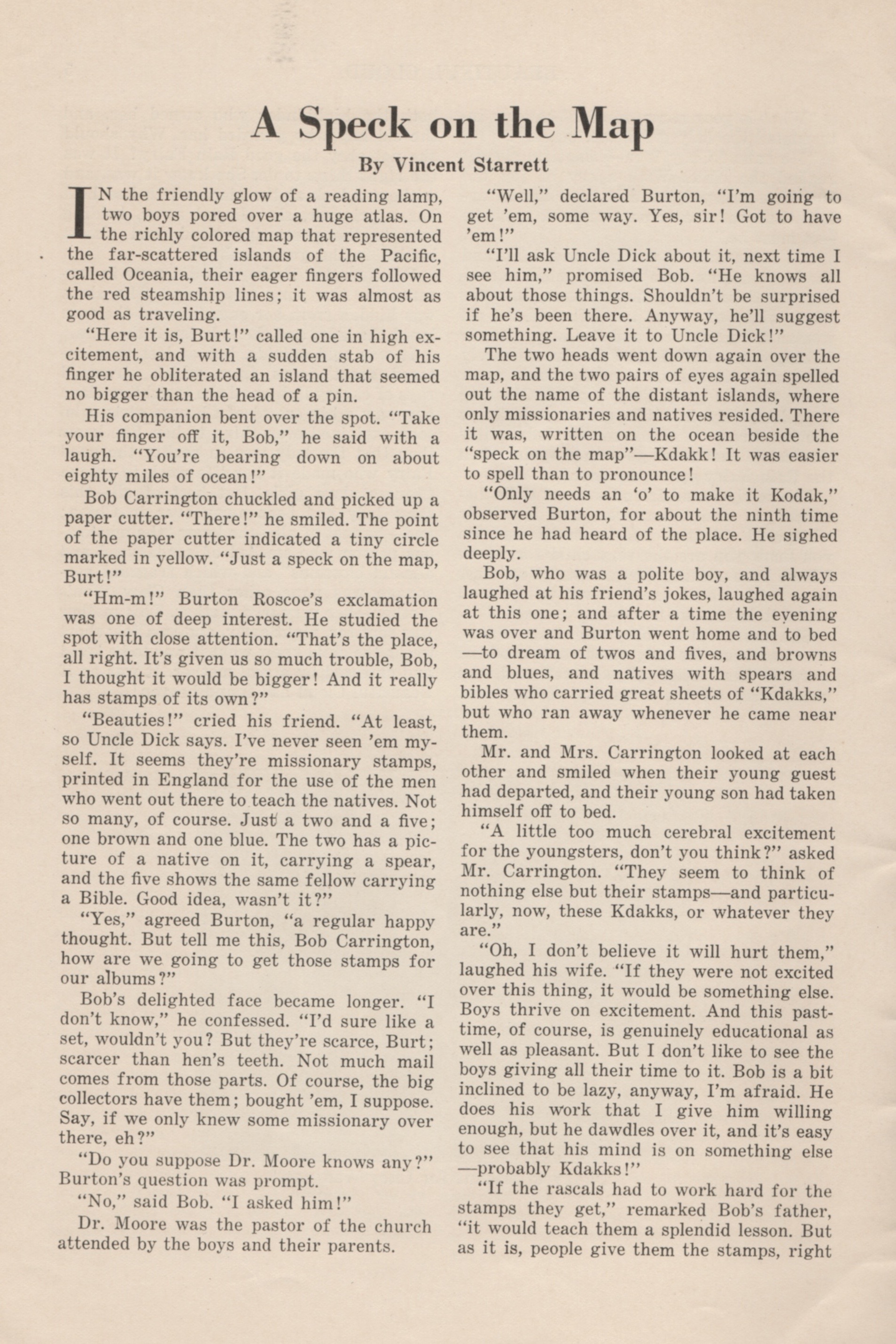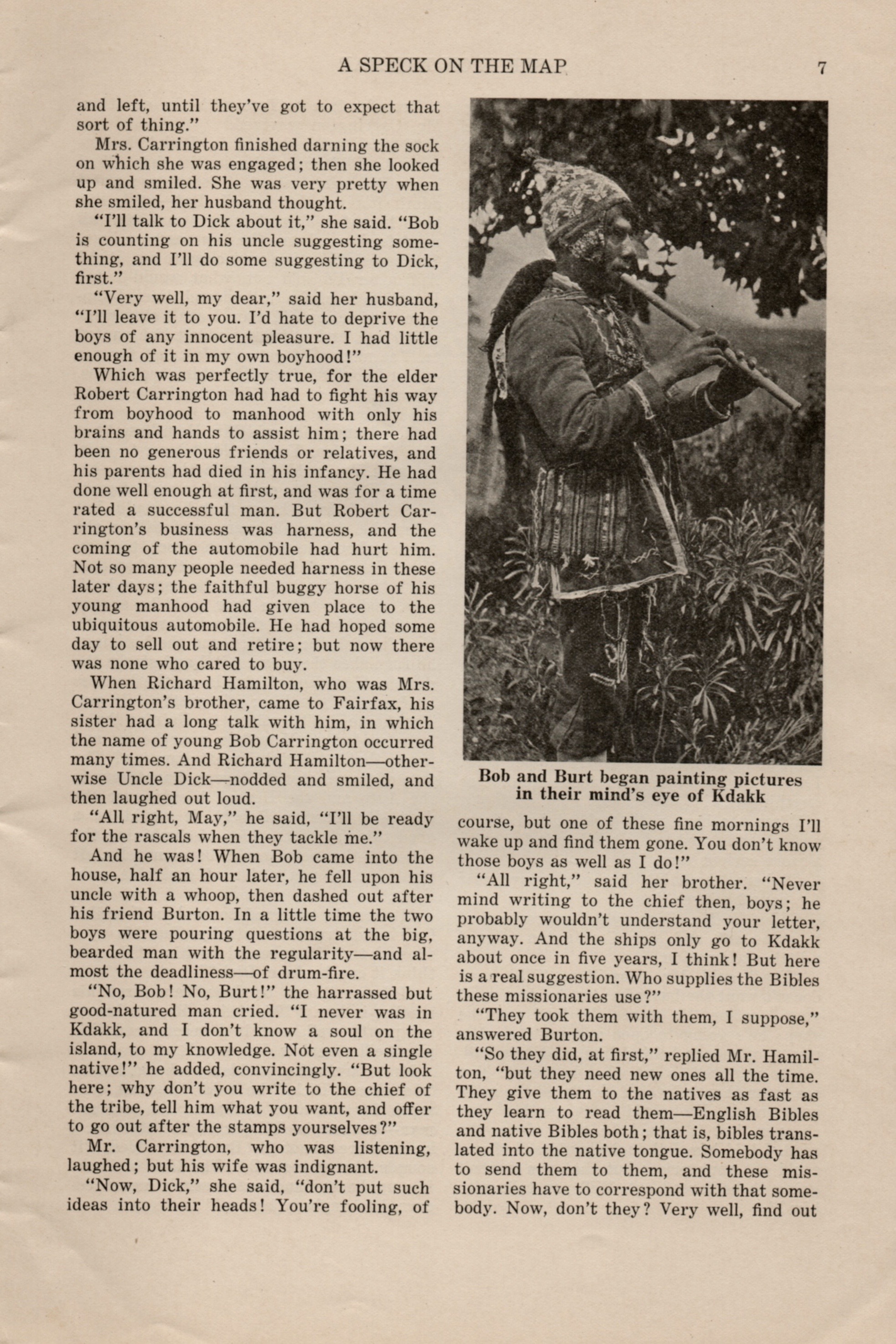“His friend Burt”
Why would Starrett name a child in a piece of fiction after one of the most vicious book reviewers of his time?
Several years ago I was at the Archive, a beautiful mess of a book and paper shop in Lansdale, Pa. about an hour north of Philadelphia. It's stuffed to the rafters with books, magazines, maps, and lots of wonderful stuff that can only be described as fascinating junk.
I stop by here once a year or so, especially on those frigid Sundays in February when outside activities are off the list. Some trips I come away with nothing more than a smile and dusty hands; other times I find treasure here. In a back room is the $5 table. It was here that I hauled out a most unusual item from the mound of paper.
Everyland magazine described itself as “A magazine of world friendship for girls and boys.” It is the kind of magazine written by grownups in a language they think children commonly use. Here's an example:
"Suppose we could hang May baskets on everybody's doorknobs all over the world. What fun it would be!" And "When children's friendships are world-wide, new ages will be glorified."
This was the May 1927 issue and it contained a most unusual story by Vincent Starrett: “A Speck on the Map.”
Starrett wrote very few pieces intended for children, and the style very much harkens back to the “juveniles” that were and important part of his late Victorian/early Edwardian childhood.
(You can read about his sole attempt at an illustrated children’s book here.)


"A Speck on the Map" is about two boys who become fascinated, no, obsessed with a tiny Pacific island called “Kdakk”.* (See the first note in "The More You Know" at the bottom of this post.)
“Just a speck on the map, Burt,” cries out Bob Carrington as the two look at an atlas one summer's day. Spurred on by Bob’s Uncle Dick, the boys are also obsessed with getting the extremely rare Kdakkian postage stamps:
“It seems they’re missionary stamps, printed in England for the use of the men who went out there to teach the natives. Not so many, of course. Just a two and a five; one brown and one blue. The two has a picture of a native on it, carrying a spear, and the five shows the same fellow carrying a Bible.”
(The idea calls up images of Starrett's mother, who was a Christian missionary in British Columbia among the natives about this time.)
The hard work the two boys must put in means missing a day at the ole swimmin’ hole, but as they haul down the last box, the two discover it contains letters with the rare Kdakk stamps—a plant by the ever resourceful Uncle Dick.
Bob’s father and business partner agree to a joint automobile/harness shop, a unusual combination that will make the little town of Fairfax famous.
“What is it now?” the new owner asks.
“Just a speck on the map!” chuckled Burton, suddenly.
And here’s the thing: The Burton is identified early in the story as Bob Carrington’s best friend, Burton Rascoe, who also just happened to be, in 1927, one of the best-known literary critics in the United States.
He was also, not surprisingly, a friend of Vincent Starrett.
The cover to "Before I Forget," Rascoe's first effort at autobiography.
Both men were not native to Chicago. Just as Starrett’s family had come from Toronto, Rascoe was an import from Oklahoma. In his excellent book named for his subject, Donald M. Hensley, notes that Rascoe was 19 when he made his way to Chicago in 1911 to attend the University of Chicago. That year, he became campus correspondent for the Chicago Inter-Ocean (where Starrett had started his newspaper career a decade earlier), then switched to the Tribune, where he began writing book reviews. By 1916, Rascoe had dropped out of college, married, become a father and was appointed chief book reviewer for the Tribune. **
Starrett was a reporter and book reviewer in Chicago at this time and the two no doubt crossed paths often at used book shops. Though both were collectors and admirers of contemporary writers, the two men took a different path in their promotion of the modernists. Starrett was a gentle persuader, urging his fellow reporters to read books by James Branch Cabell, Haldane McFall, Ambrose Bierce, Arthur Machen, Stephen Crane and Robert Louis Stevenson.
Rascoe was a firebrand, picking fights with those who defended the Edwardian sensibilities and going into battle for his favorites, especially H. L Mencken.
“Undoubtedly the liveliest book critic in Chicago during the first years of the renascence was the late Burton Rascoe, who became the Tribune’s first reader in 1917,” recalled Starrett in his memoirs, Born in a Bookshop. “It is not too much to say that then, at that certain moment, and always excepting H.L. Mencken, he was the most influential book critic in the country.”
Starrett admired Rascoe’s passion, even if it did mean his friend Burt needed to hunt up a new job every few years.
Rascoe's autograph.
“He had an alert and discriminating intelligence,” says Starrett. “He was young, brash, enthusiastic, and knowledgeable. No more unbridled and, withal, scholarly and effective cultural force ever was loosed on a lethargic and complacent community.”
In an unpublished manuscript, written around 1922, Starrett was more emphatic about Rascoe’s style and influence. ***
“He (Rascoe) conducted sizzling rows with his critical contemporaries on the other journals, suavely insulted the most popular writers of the day so that they wrote furious replies, which he printed with delight, and generally pepped up the culture f the community. … He contradicted the Great God Mencken, and arranged an exchange of incivilities between Cabell and Rupert Hughes that must take its place beside the Whistler-Ruskin controversy. In short, he raised a great deal of hell in Chicago, and his influence is still felt.”
Indeed, Starrett believed Rascoe deserved a lion’s share of the credit for the literary flowering that took place in Chicago during the early 1910s and ‘20s.
“If Chicago was then the center of the most exciting literary movement in the country, it was so in no small degree because Rascoe occupied one of the editorial chairs and rode it, cavalry fashion, with spurs.”
Rascoe returned the admiration.
The rear dust jacket from Before I Forget. Finding a photo of Rascoe that isn't under copyright was difficult. This was the only image I could unearth.
“Starrett educated the whole prolific local room of the Chicago Daily News; he educated scores of groping readers in bookshops and barrooms; he is probably at this moment educating numerous amateurs, dilettantes and young reporters,” wrote Rascoe after leaving Chicago for New York.
“He (Starrett) was, I believe, to a large extent responsible for for the enthusiasm for good literature which became so infectious among the Chicago reporters that for a long tie the local news stories in the Chicago newspapers were the most readable, the best written in the country.” ****
Rascoe also recognized the very different style his friend Starrett had for promoting his enthusiasms.
“Starrett’s educative influence was pervasive rather than direct, so pervasive and indirect, in fact, that many of those who owe him the most would probably deny the obligation,” Rascoe wrote.
Perhaps it was the mutual admiration that prompted Starrett to name his young protagonist Burton Rascoe. Or there might have been an “in-joke” that the two would have enjoyed while enjoying a beverage or two.
I would like to think it has something to do with the origin of the word Kdakk.
The More You Know
* Kdakk appears to have been invented by Starrett. Based on the story, it’s a tiny island whose natives are largely the spear-chucking, ignorant men and women that would have been at home in a book by Edgar Rice Burroughs or H. Rider Haggard.
**Burton Rascoe by Donald M. Hensley, published in 1970 by Twayne Publisher’s Inc. of New York. Much of Rascoe’s life story cited here comes from this book, unless otherwise noted.
*** Hensley quotes from this manuscript found in the Burton Rascoe Collection at the University of Pennsylvania.
**** From “Starrett and the Chicago Renaissance” by Burton Rascoe, first published in the New York Herald Tribune and reprinted, in part, in Shaking Hands with Immortality: Encomiums for Vincent Starrett edited by Michael Murphy and published in 1975 by The Printery in Kirkwood, MIssouri.
